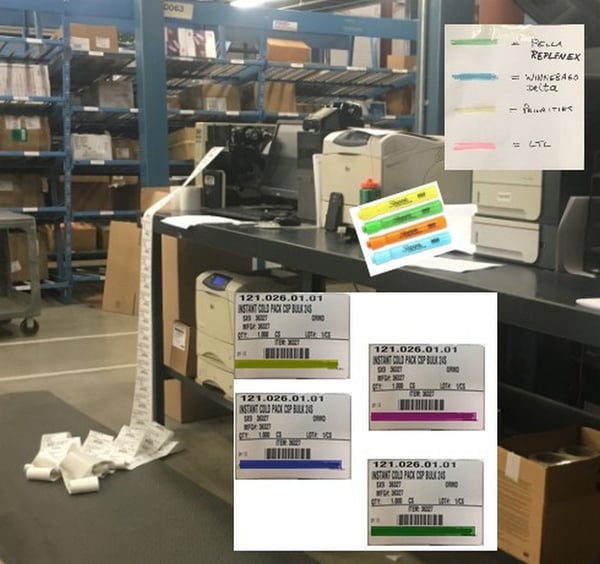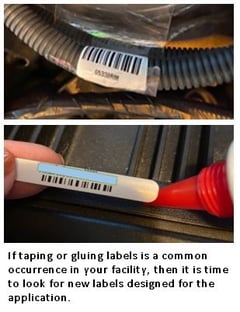
We regularly cover many of the core processes that a warehouse or production line work to optimize every day, with a particular focus on how to measure and improve them. While “labeling” is a key part or outcome in many of these processes, it’s generally not referred to as its own “process”.
But what if we took a deeper look at the details of the labeling “process” itself? Regardless of where and when it happens within the other core processes, labeling has its own set of do’s and don’ts that can make a difference to your business and your customers.
Our own Kevin Ledversis recently presented a webinar with our partners at Zebra Technologies and Teklynx and revealed some common “label process” issues that are common across all the core warehouse processes that use labels.
Gemba Walk for Labels
Doing a “Gemba Walk” through the life cycle of your labels can be revealing. Here are the places to look for improvement opportunities and how they may be impacting your business:
- Long-term storage – Are the labels still easy to read? Are they still firmly adhering to the cartons? Are they being stored indoors or outdoors? For inventory stored outside, the peeling or fading may be more from the elements than from the factors impacting those items inside.
- Scanning Gateways – automatic scanning stations built into conveyor systems or tray sorters may be slowed, backed up or kicking out excessive exceptions because of poor label readability.
- Conveyors/Rollers/Chutes – are loose labels accumulating more frequently at some points of contact than others? In this scenario, there are potentially adjustments that need to be made to your equipment where your labels get rubbed or impacted so they do not come off, but it also speaks to your labels having adhesive problem.
- Label Quality – poor print quality and readability issues could be coming from the wrong label/ribbon combination, which is common when high-speed printers aren’t operated with the appropriate labels.

- DIY Label Fixes – Are packages going out with labels taped over or with extra glue because they do not adhere? Have there been markings made to improve readability add visual cues for sorting?
- Return Problems – The Returns area tracks reasons for returns. How many things are coming back because they were missing labels or had inaccurate or unreadable labels?
- Maintenance Schedule – how often are your printheads replaced? IS there a regular maintenance schedule and routine? If you don’t have maintenance records you won’t be able to eliminate this very common problem as a source of your issues.
- Printer locations – as readers of this blog will already know, stationary printers in centralized locations generate – walking! Lots of unnecessary steps are a path to wasted hours and higher label costs, with more opportunities for mistakes while labels are being carried around between printers and where they are intended for use. Relocating to where the labels will be used or even better – putting them on a cart – will reduce labor and mistakes associated with your label process.
Building a Better Label Process
After documenting everything you see on the floor and listening to the people who are working with the labels (or impacted by the issues resulting from poor labeling), get back to your desk and begin putting together your labeling requirements again but in a way that will address the challenges you found out on the floor.
- Find an Expert - this is not a recommendation to pass the buck on determining a solution, but rather a best practice to get the right solution. Given that there are thousands of combinations of label stock, varnish and adhesives, getting the right one is not easy for the rest of us. The factors that impact the choice of labels will make that clear below.
- Environment – document the ENTIRE journey of EACH type of label you need. A shipping label that gets applied, shipped and thrown away two days later might get away with being a common 4x6 stock label, but something that will potentially be in use 12 months or longer and pass through different environments – cold, humidity, water (or even outer space!)
- Application Process – are the labels being STORED in a cold environment or APPLIED in a cold environment? Believe it or not, this apparently subtle difference results in a different adhesive requirement. The temperature, humidity and exposure to elements matters for both the time the label is applied AND for where it will be stored while on the product.
- Printer Capacity and Maintenance – if you don’t do this already, make a table listing all your printers, their locations, purpose, label and ribbon being used, daily (required) output, date of printhead replacement, etc. You’ll want to set up a system where you regularly replace printheads and perform other maintenance as recommended.
- Keep the Right Label in Stock – once you have the right label at the right quality, make a point to ensure you don’t get caught running out of them or substituting others for them to save a few dollars. Once you go through that process to get the right supplies, make sure the team knows WHY those labels are there and that substitutes may create problems. Many resellers will allow you to purchase a year’s worth of labels in advance and store them FOR you so you can have them replenished when needed during the year – usually on a quarterly basis.
Labeling Impacts Customer Satisfaction
While the “labeling process” is not always a core focus for process analysts and managers, it does impact customer satisfaction – especially when it is not working properly. Delayed or mistaken deliveries, lost packages, etc. are almost 100% preventable with a smooth-running label process.
Download The Warehouse Guide to Lean Labeling to start creating better awareness of the label problems you may not see and how to address them.